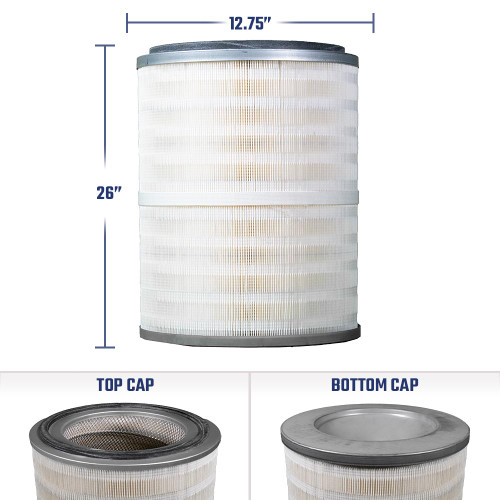How To Properly Measure & Identify A Dust Collection Cartridge Filter
How To Properly Measure & Identify A Dust Collection Cartridge Filter
The Filter Junkie team is all about making things as easy as possible for customers. We are confident that we will get the exact filter you need, guaranteed. When searching for a filter how do you know what all to look for when buying a new one? One of the main questions we get is, “what size filter do I need?” To determine the exact size, follow these steps we’ve outlined for you.
One of the most frustrating parts of replacing your filter is trying to figure out what size you need. If you aren’t familiar with industrial filters and how to know the exact size you need, we’ve created a guide for you. When measuring and identifying an industrial cartridge filter, typically there are several factors to consider.
How to measure the overall length of your filter
To measure overall length, it is critical that the measurement be from cap to cap. An important note to be aware of - this does not include the gasket. See the illustration below for an example.

Measuring the outside diameter of the cartridge
Make sure you measure the outside diameter of the filter, an important detail when choosing a new filter. The measurement of the outside diameter of an industrial filter is from outside of the metal cap from side to side (assuming it’s round filter).
The inside diameter measurement is very important
When picking out a filter get the measurement of the inside diameter. This is critical as this may affect the fit of the filter in the dust collector itself, over a filter holder of some type or the fit of the tube sheet against the seal.
Make note of the cage construction
The cage construction is the design of the inner and outer portion of the dust collector cartridge. In almost all cases, there is an inner cage. Most are made of metal. This gives support structure to the filter. The varying aspects of design typically are on the outer construction. Some filters have an outer metal cage or screen. Some filters have no outer cage and no outer support. Others have external bands to hold the pleats of the filter in the proper location. As you can tell there are lots of variations of cage constructions so make sure to look for that detail when selecting your filter.
What media type do I need?
Once you have identified the size, shape, and construction of the filter, it’s time to determine the filter media itself. This is the most critical factor, other than the design component. The filter media type is determined by the application of the product and/or the dust collection unit it is used in. There are a multitude of media types ranging in filtration efficiencies, temperature ranges, fire retardant or not, durability and moisture resistance. See our media selection blog for an in-depth discussion of media types. The most common in dust collection are 80/20 (80% cellulose/20% Polyester), Nanofiber, and Spunbond Polyester.
Consult your filter expert on which media is best for your application. For example, if you are collecting laser smoke and dust from a high-speed metal cutting laser, it would be critical to have a very high efficiency filter that is fire retardant and highly cleanable due to the very fine and sticky nature of the dust. In this case, we would recommend a nanofiber in fire retardant, Merv 15 rated (highest efficiency in cleanable filter media).
Gasket and temperature considerations
The last major component of filter design is the gasket, glue, and epoxy portions of the filter. Does the filter need to be rated above a standard temperature rating of 120 degrees Fahrenheit? Is there an oily component where a special seal might be needed? Is the filter for use in food where a special FDA rated gasket might be needed?
We are your filter fanatics
Filter Junkie knows it all when it comes to filtration. We have over 25 years’ experience in manufacturing filtration. For help in identifying your cartridge filters, visit us at www.filterjunkie.com and email, call, or chat with one of our filter experts.



